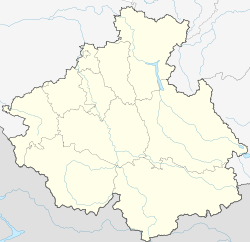전갈자리 V636
V636 Scorpii| 관측 데이터 에폭 J2000 이쿼녹스 J2000 | |
|---|---|
| 별자리 | 전갈자리 |
| 우측 상승 | 17h 22m 46.47796s[2] |
| 탈위임 | −45° 36′ 51.3868″[2] |
| 겉보기 크기(V) | 6.40 - 6.92[3] |
| 특성. | |
| 세페이드 | |
| 스펙트럼형 | F7/8Ib/II-G5[3] |
| 변수형 | Δ Cep[3] |
| 동반자 | |
| 스펙트럼형 | B9.5V[4] |
| 아스트로메트리 | |
| 방사 속도(Rv) | 9.09 ± 0.17km[5]/s |
| 적정운동(μ) | RA: -3.05 ± 1.03[2]mas/yr Dec.: -2.40 ± 0.38[2]mas/yr |
| 시차(시차) | 1.15 ± 0.76 마스[2] |
| 거리 | 약 3천 리 (약 900pc) |
| 절대치수(MV) | -3.64[4] |
| 궤도 | |
| 기간(P) | 1318일[4] |
| 반주축(a) | 6.7[4] |
| 편심률(e) | 0.26[6] |
| 세부 사항 | |
| 세페이드 | |
| 미사 | 5.6[4] M☉ |
| 반지름 | ~50[7] R☉ |
| 루미도 | 2,500[4] L☉ |
| 금속성 | +0.07[8] |
| 동반자 | |
| 미사 | 2.4 M☉ |
| 기타 지정 | |
| 데이터베이스 참조 | |
| 심바드 | 자료 |
V636 전갈자리 V636 전갈자리(전갈자리)는 3,000광년 떨어진 전갈자리(전갈자리)에 있는 다중 항성계통이다.일차변수는 고전 세페이드(Δ 세페이) 변수로서 시각적 크기는 6.4에서 6.9까지 다양하다.
V636 전갈자리 V636 전갈자리 는 분광형 이항성으로, 기절하는 동반자는 그 자체로 두 개의 별들로 이루어져 있다고 생각된다.1차적으로는 야광 황색 별과 Δ 세페이 변수다.매 3.6년마다 더 적은 질량의 동반 궤도를 그리며 B9.5의 주계열성인 것으로 보이지만, 이 계통의 역학관계는 실제로 한 쌍의 항성일 수도 있다는 것을 암시한다.[9]
세페이드 1차는 6.79671일의 기간으로 규칙적으로 맥동한다.태양보다 5.6배, 광도보다 2500배 큰 황백색 초거성 또는 밝은 거성이다.[4]
참조
- ^ "MAST: Barbara A. Mikulski Archive for Space Telescopes". Space Telescope Science Institute. Retrieved 8 December 2021.
- ^ a b c d e Van Leeuwen, F. (2007). "Validation of the new Hipparcos reduction". Astronomy and Astrophysics. 474 (2): 653–664. arXiv:0708.1752. Bibcode:2007A&A...474..653V. doi:10.1051/0004-6361:20078357. S2CID 18759600.
- ^ a b c Samus, N. N.; Durlevich, O. V.; et al. (2009). "VizieR Online Data Catalog: General Catalogue of Variable Stars (Samus+ 2007-2013)". VizieR On-line Data Catalog: B/GCVS. Originally Published in: 2009yCat....102025S. 1. Bibcode:2009yCat....102025S.
- ^ a b c d e f g Evans, Nancy Remage; Bond, Howard E.; Schaefer, Gail H.; Mason, Brian D.; Karovska, Margarita; Tingle, Evan (2013). "Binary Cepheids: Separations and Mass Ratios in 5M ⊙ Binaries". Astronomical Journal. 146 (4): 93, 10 pp. arXiv:1307.7123v1. Bibcode:2013AJ....146...93E. doi:10.1088/0004-6256/146/4/93. S2CID 34133110.
- ^ Pourbaix, D.; Tokovinin, A. A.; Batten, A. H.; Fekel, F. C.; Hartkopf, W. I.; Levato, H.; Morrell, N. I.; Torres, G.; Udry, S. (2004). "SB9: The ninth catalogue of spectroscopic binary orbits". Astronomy and Astrophysics. 424 (2): 727–732. arXiv:astro-ph/0406573. Bibcode:2004A&A...424..727P. doi:10.1051/0004-6361:20041213. S2CID 119387088.
- ^ Evans, Nancy Remage; Carpenter, Kenneth G.; Robinson, Richard; Kienzle, Francesco; Dekas, Anne E. (2005). "High-Mass Triple Systems: The Classical Cepheid Y Carinae". The Astronomical Journal. 130 (2): 789–793. arXiv:astro-ph/0504169. Bibcode:2005AJ....130..789E. doi:10.1086/430458. S2CID 119342828.
- ^ Moskalik, P.; Gorynya, N. A. (2005). "Mean Angular Diameters and Angular Diameter Amplitudes of Bright Cepheids". Acta Astronomica. 55: 247. arXiv:astro-ph/0507076. Bibcode:2005AcA....55..247M.
- ^ Marsakov, V. A.; Koval', V. V.; Kovtyukh, V. V.; Mishenina, T. V. (2013). "Properties of the population of classical Cepheids in the Galaxy". Astronomy Letters. 39 (12): 851. Bibcode:2013AstL...39..851M. doi:10.1134/S1063773713120050. S2CID 119788977.
- ^ Böhm-Vitense, E.; Evans, N. R.; Carpenter, K.; Albrow, Michael D.; Cottrell, P. L.; Robinson, R.; Beck-Winchatz, B. (1998). "The Mass of the Cepheid Binary V636 Scorpii". The Astrophysical Journal. 505 (2): 903. Bibcode:1998ApJ...505..903B. doi:10.1086/306177.



